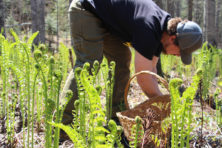Micro-trenching Pitched as an Underground Fiber Solution
- Share
- Tweet
- Pin
- Share
Where roads aren’t wide enough to install internet fiber or telephone poles for aerial installation are unavailable, microtrenching the fiber into the ground is arising as a possibility.
Rob Webb, vice president of innovation with the internet service provider Nsight, presented his company’s proposed micro-trenching technique to the Door County Highway and Facilities Committee in August. He explained the method cuts a narrow trench into the roadway about two feet away from the curb and buries the conduit beneath the pavement into the road’s substructure. The road is repaired afterwards by pouring a slurry mix into the trench to fill all pores and openings. That’s then topped off on low-traffic roads with asphalt. On county roads, they’d mill off the top layer of pavement above the trench before re-asphalting.
He said they’d only propose micro-trenching where there’s not a significant amount of right-of-way or where numerous trees would need to be cut down. Along certain stretches of County Road F in Baileys Harbor, for example, there is not enough shoulder and they can’t maneuver machines without removing trees. The town selected Nsight as its broadband partner in 2022.
“It would not be throughout the entire county on every road but where it’s extremely narrow,” Webb said. On that County Road F stretch, they would micro-trench “only in a small section,” Webb said. “Once I get out to where poles are, I would probably transition to an aerial solution because it’s less expensive.”
Stringing fiber on telephone poles “is still cheaper where there are poles,” Webb said, but he said micro-trenching is cheaper than burying cable in the soil along the right-of-way.
Nsight has yet to use micro-trenching anywhere in Wisconsin. The company presented the technique to the Wisconsin Department of Transportation (Wis-DOT) in July, Webb said, seeking approval to test it for use on state roads. Webb told the committee that Nsight’s goal was to also receive the county’s recommendation to use the technique.
Ken Pabich, county administrator, said the county highway department usually follows Wis-DOT recommendations, and the towns are looking for guidance from the county. But since the state hasn’t approved micro-trenching as a viable solution at this time, Pabich told the highway committee that Webb’s presentation was largely educational.
“I’m not promoting it one way or another, it’s just a technology I think we should look at,” Pabich said.
Pabich said while the technique “might not be a viable solution this year,” they may be able to work with Wis-DOT on endorsing the technology by next spring.
“I think there is some due diligence we need to do and some research,” he said.



